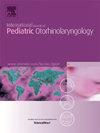Open access 3D printed open airway reconstruction and rib cartilage carving simulation model
IF 1.2
4区 医学
Q3 OTORHINOLARYNGOLOGY
International journal of pediatric otorhinolaryngology
Pub Date : 2025-03-24
DOI:10.1016/j.ijporl.2025.112321
引用次数: 0
Abstract
Objective
To create a cost-effective, high-fidelity, and easily reproducible model for open airway reconstruction simulation.
Methods
3D printing and molding techniques were used to create silicone-based laryngotracheal and rib cartilage models. Models were utilized in an open airway reconstruction and cartilage graft carving simulation lab at a tertiary academic center in January 2024. Participants were surveyed regarding their confidence in performing key portions of the surgery (carving of anterior and posterior grafts, parachuting suture technique, tracheal resection and anastomosis). Surveys were collected at three time points (baseline, post-lecture, and post-simulation lab). Impact on participant confidence was analyzed using paired t-test.
Results
The airway and cartilage models were able to be fashioned quickly with a very low cost. The cost per model for the airway and rib cartilage models were $0.53 and $0.13, respectively. Thirteen participants completed the lab and surveys. When the simulation and post-lecture surveys were compared to the baseline survey, a statistically significant improvement in confidence was noted. Comparison of post-simulation and post-lecture surveys demonstrated statistically significant improvement (p < 0.001) with a large effect size (Cohen's d ≥ 1.58) for all survey items. Models were found to be of high fidelity based on the assessment questions.
Conclusion
With this simulation study, we demonstrated increased confidence for residents in understanding of key steps involved in open airway reconstruction and cartilage carving using cheap and high-fidelity models. All files will be made open source to increase accessibility and reproducibility.
开放存取3D打印开放气道重建及肋软骨雕刻仿真模型
目的建立成本效益高、保真度高、易于复制的开放气道重建模拟模型。方法采用3d打印和成型技术制作硅胶喉气管和肋骨软骨模型。模型于2024年1月在某三级学术中心开放气道重建和软骨移植雕刻模拟实验室使用。参与者被调查了他们对执行手术关键部分的信心(前后移植的雕刻,降落伞缝合技术,气管切除和吻合)。调查在三个时间点(基线、讲座后和模拟实验后)收集。采用配对t检验分析对参与者信心的影响。结果气道和软骨模型可以快速成型,成本很低。气道模型和肋软骨模型的成本分别为0.53美元和0.13美元。13名参与者完成了实验和调查。当模拟和课后调查与基线调查进行比较时,统计上显着提高了信心。模拟后和课后调查的比较显示统计学上显著的改善(p <;0.001),所有调查项目的效应量都很大(Cohen’s d≥1.58)。基于评估问题,发现模型具有较高的保真度。通过这项模拟研究,我们证明了住院医师对使用廉价和高保真模型的开放气道重建和软骨雕刻的关键步骤的理解增加了信心。所有文件都将是开源的,以增加可访问性和可再现性。
本文章由计算机程序翻译,如有差异,请以英文原文为准。
求助全文
约1分钟内获得全文
求助全文
来源期刊
CiteScore
3.20
自引率
6.70%
发文量
276
审稿时长
62 days
期刊介绍:
The purpose of the International Journal of Pediatric Otorhinolaryngology is to concentrate and disseminate information concerning prevention, cure and care of otorhinolaryngological disorders in infants and children due to developmental, degenerative, infectious, neoplastic, traumatic, social, psychiatric and economic causes. The Journal provides a medium for clinical and basic contributions in all of the areas of pediatric otorhinolaryngology. This includes medical and surgical otology, bronchoesophagology, laryngology, rhinology, diseases of the head and neck, and disorders of communication, including voice, speech and language disorders.

 求助内容:
求助内容: 应助结果提醒方式:
应助结果提醒方式:


